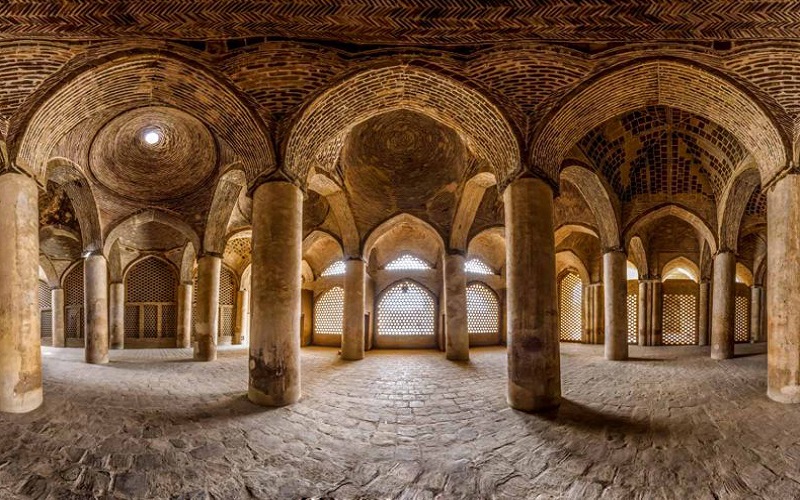Simultaneously with the subsidence crisis in the plains of Fars province, a member of the academic staff of Shiraz University announced that this phenomenon is within 300 meters from Persepolis and has caused 70-centimeter cracks in the Naqsh-e Rustam area.
Maryam Dehghani, a member of the academic staff of the Department of Civil Engineering and Environmental Engineering at Shiraz University, stated in an interview with the regime’s semiofficial ILNA news agency on September 24 that a subsidence edge has reached about 10 to 15 meters from the ancient area of Naqsh-e Rustam, and the width of these cracks ranges from half a meter to 70 centimeters, which fill up with sand and sediment every year but reopen again.
According to Dehghani, “Although Persepolis is not affected by subsidence, a subsidence of about 10 to 15 centimeters has occurred within 300 meters of it due to its location in the mountainous region.”
In recent years, experts have repeatedly warned about the critical subsidence of land in various areas of Iran and the serious damage to historical and ancient artifacts.
On June 7, the Hammihan newspaper, citing an unnamed archaeologist, mentioned historical structures in Isfahan that have been affected by subsidence.
The archaeologist considered the presence of “longitudinal cracks” in these structures as a sign of subsidence and added that traces of this phenomenon can also be seen on the entrances, domes, and walls of the Jame’a Mosque of Isfahan.

In this regard, Bahram Nadi, a university professor and member of the specialized subsidence committee in Isfahan, stated on September 19 that the dome of the Jame’a Mosque of Isfahan has tilted, and the columns of the mosque have become crooked and broken as a result of subsidence.
The head of the Shiraz Tourism Council also stated in December 2021 that the northern Vakil Bazaar in Shiraz is collapsing, and despite the possibility of numerous life-threatening risks, no action is being taken by authorities.
Mehrdad Veis Karami, the representative of Khorramabad in the Islamic Consultative Assembly, also warned about the subsidence of Falak-ol-Aflak Castle in Lorestan province in the same year.
The phenomenon of land subsidence, which has affected many plains in Iran, has not only caused damage and destruction to historical structures but has also had an impact on the lives of millions of people. According to experts, it will lead to financial losses and even casualties in the not-so-distant future. For example, Majid Nasimi, the Director-General of School Renovation in Isfahan province, stated on September 23 that “40 schools in the province have been damaged due to land subsidence. Out of this number, the situation of six schools was deemed hazardous, and we were forced to issue an evacuation order for them.”
In recent years, numerous reports of sudden ground subsidence in streets and residential areas in various cities have been published.
Experts consider the excessive extraction of groundwater as the main cause of land subsidence in Iran. The situation is described as critical in several provinces including Tehran, Alborz, Isfahan, Fars, Kerman, Hamadan, Semnan, Qazvin, Khorasan Razavi, North Khorasan, and Yazd.
The head of the National Crisis Management Organization announced on June 11 that 602 plains in the country are prone to subsidence.
Mohammad Ali Fahimi, the head of the Subsurface Water Studies Group at the Regional Water Company of Yazd Province, stated on June 14 to the state-run ISNA news agency that the danger of land subsidence and the occurrence of sinkholes not only cause significant damage to the infrastructure of the province every year but also extend to within a few hundred meters of people’s homes in some areas of the province. In addition to financial losses, it poses a “mortal threat.”
He also stated that land subsidence is “irreversible and creeping.” The annual land subsidence in some areas such as the southern part of Tehran plain, as well as the plains of Fasa and Jahrom, reaches 40 to 54 centimeters per year, which is “100 times higher than the global standard and is a terrifying record.”
Experts have attributed the phenomenon of land subsidence to the excessive extraction of groundwater, especially in Tehran, Alborz, Isfahan, Fars, Kerman, Hamadan, Semnan, Qazvin, Khorasan Razavi, North Khorasan, and Yazd provinces.
If there is a popular government in Iran, the water crisis will undoubtedly be resolved, and the first and most accessible way to invest in the agriculture sector.
Mechanizing Iran’s agriculture with drip irrigation system and pressurized system will save a lot of water.
It is possible to invest in the water sector and save the land of Iran from extinction and destruction.
But the regime’s priorities are acquiring atomic bombs, exporting terrorism and fundamentalism, and developing ballistic missiles.
There are thousands of villages that are currently supplied with drinking water by tankers, and millions of Iranians are forced to leave their cities and villages and go to the slums or large cities due to lack of water, and the regime has done nothing for them.